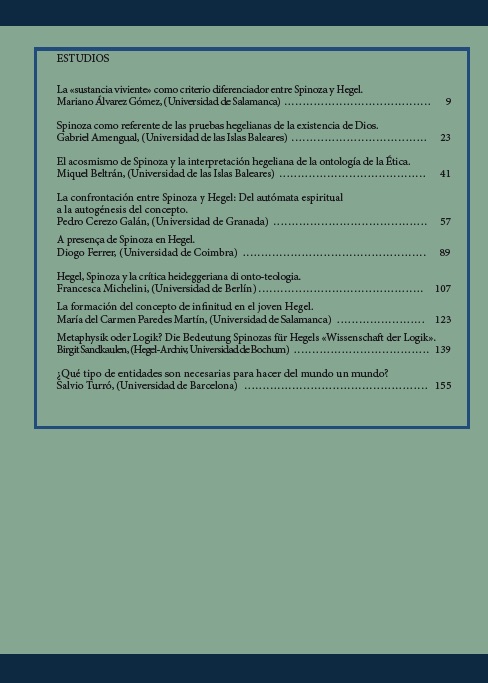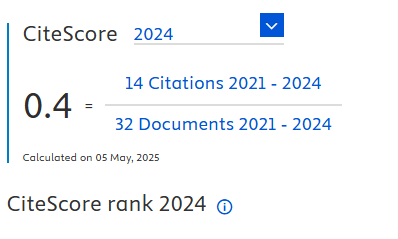La confrontación entre B. Spinoza y G.W.F. Hegel: del «autómata espiritual» a la «autogénesis» del concepto The confrontation between B. Spinoza and G.W.F. Hegel: from the «spiritual automaton» to «autogenesis» of the Concept
DOI:
https://doi.org/10.24310/stheg.v0i1.3696Keywords:
Autogénesis del Concepto, Reflexión, Exposición, Autómata EspiritualAbstract
Resumen: Como indica el subtítulo, he optado por una hermenéutica de la distancia y el contraste entre ambos pensadores, en lugar de buscar aproximaciones y afinidades entre ellos, como suele ser habitual: 1º): del autómata espiritual a la autorreflexión fenomenológica: El planteamiento epistemológico que lleva a cabo Spinoza en De intellectus emendatione, se basa en una teoría de la evidencia (idea vera), cuya reflexión (idea ideae) es meramente especular, pues presupone la idea vera como exemplar naturae. En cambio, Hegel se propone “construir lo absoluto para la conciencia” o introducir a la conciencia en lo absoluto, y en su Fenomenología desarrolla el modelo dialéctico de una autocrítica interna de la experiencia del conocimiento, que implica una autorreflexión de la conciencia in vía, como transformación interna de sí. 2º): la manifestación de lo absoluto: ¿expresión o exposición”(Darstellung)? El automatismo epistémico se funda en Spinoza en una teoría ontológica de la expresión, conforme al modelo de involvere/exprimere, propio de una metafísica naturalista de la inmanencia, anticreacionista y antiemanantista. En Hegel, en cambio, la manifestación corresponde al modelo de exire et redire, lo que implica el acontecimiento de la escisión (Entzweiung), esto es, de un separador interno y mediador (Böhme, Plotino), en la salida y el retorno, y, por tanto, de una negatividad activa en el seno de lo absoluto. 3º): reflexión externa y reflexión interna. El modelo de reflexión externa es el empleado por Parménides, en su metafísica monista (to eon, hen, houlon), mediante la abstracción de las diferencias, que Hegel aplica a Schelling y Spinoza. En el modelo hegeliano, por el contrario, el contraponer es el mismo movimiento inmanente de la actividad de la reflexión de lo absoluto, en el tránsito de su identidad abstracta a la identidad concreta. Ahora bien, este movimiento autorreflexivo implica una doble negación progresiva, que se lleva a cabo en la salida de la sustancia al atributo y de éste al modo. El modo finito se convierte así en el gozne mismo de la reflexión. 4º) Por último, el contraste entre la sustancia activa y la autogénesis del concepto. En Spinoza, la causa sui no es la esencia de la sustancia, sino una propiedad, que expresa la incondicionalidad del infinito en acto, y, en cuanto tal, presupone la precedencia formal de la definición esencial de la sustancia. Para Hegel, causa sui es la categoría, realmente especulativa, que aporta la clave para entender la actividad de la sustancia como relación “absoluta” de sí con-sigo (para sí). Hegel identifica así formalmente causa sui (Ursache) y cosa originaria (Ur-Sache). La causa sui encierra la contradicción de un ponerse como efecto y de un eliminar lo así puesto, en retorno hacia sí. De ahí que la sustancia ya no sea “el tranquilo proceder de sí en los accidentes, sino el activo pro-ducirse (hervorbringen) de la sustancia en cuanto sí misma. Por tanto, en el genitivo objetivo y subjetivo del sui, acontece el “sí mismo” (Selbst) del concepto. Se vuelve así la sustancia espiritual” en el autoengendrarse (Selbsterzeugen) de su concepto.
Palabras clave: Autogénesis del Concepto - Reflexión - Exposición – Autómata Espiritual
Abstract: As indicated by the subtitle, I opted for a hermeneutics of distance and for the contrast between the two thinkers, rather than seeking approaches and affinities between them, as usual: 1st): from the spiritual automaton to phenomenological self-reflection: The epistemological approach performed in De intellectus emendatione by Spinoza, is based on a theory of evidence (idea vera), whose reflection (idea ideae) is merely specular, since it presupposes the idea vera as exemplar naturae. Instead, Hegel proposes «to construct the absolute for consciousness” or to introduce consciousness into the absolute, and in his Phenomenology, he develops the dialectical model of internal self-criticism of the experience of knowledge, which involves self-reflection of consciousness in via, as internal transformation of itself. 2nd): the appearance of the absolute, expression or exposure» (Darstellung)? Spinoza’s epistemic automatism is based on an ontological theory of the expression, according to the model involvere/exprimere, pertaining to a naturalist anti-creationist and antiemanationist, metaphysics of immanence. In Hegel, however, appearence corresponds to the exire et redire model, which implies the event of dichotomy (Entzweiung), i. e., an internal and mediating separator (Böhme, Plotinus), in exit and return, and therefore an active negativity within the absolute. 3rd): external and internal reflection. The external reflection model is used by Parmenides, in his monistic metaphysics (to eon, hen, houlon), by abstracting the differences, which Hegel applies to Schelling and Spinoza. In the Hegelian model, however, to oppose is the same immanent movement of the activity of absolute’s reflection, in the transition from its abstract identity to the concrete identity. However, this self-reflecting movement involves a double progressive negation, which is held in the outcome of substance to attribute and of attribute to mode. Finite mode becomes the hinge of reflection. 4th) Finally, the contrast between the active substance and the autogenesis of concept. In Spinoza, causa sui is not the essence of the substance, but a property that expresses the unconditionality of infinitum actu, and, as such, it assumes the formal precedence of essential definition of the substance. For Hegel, however, causa sui is the really speculative category that provides the key to understanding the activity of the substance as an «absolute» relationship of itself to itself (for-itself). Hegel thus formally identifies causa sui (Ursache) and original thing (Ur-Sache). The causa sui entails the contradiction of putting itself as an effect and eliminating the positing, in returning to itself. Hence the substance is no longer «als ruhiges Herworgehen ihrer selbst», sondern das tätige hervorbringen der Substanz als Selbst. Therefore, the «self» (Selbst) of the concept happens in the subjective and objective genitive of sui,. It becomes “spiritual substance», in the self-engender (Selbsterzeugen) of its concept.
Key words: Autogenesis of Concept – Reflection – Exposure – Spiritual Automaton
Downloads
Metrics
Publication Facts
Reviewer profiles N/A
Author statements
Indexed in
-
—
- Academic society
- N/A
- Publisher
- Universidad de Málaga
Downloads
Published
How to Cite
Issue
Section
License
This journal provides immediate free access to its content under the principle of making research freely available to the public. All contents published in Studia Hegeliana. Journal of the Spanish Society for Hegelian Studies, are subject to the Creative Commons Attribution-NonCommercial-ShareAlike 4.0 licence (specifically, CC-by-nc-sa), the full text of which can be found at <http://creativecommons.org/licenses/by-nc-sa/4.0>. Derivative works are therefore permitted as long as they are not used for commercial purposes. The original work may not be used for commercial purposes. The journal is not responsible for the opinions expressed by the authors of the works published in it.
It is the authors' responsibility to obtain the necessary permissions for images that are subject to copyright.
Authors whose contributions are accepted for publication in this journal retain the copyright. It is non-exclusive right to use their contributions for scholarly, research and educational purposes, including self-archiving or deposit in open access repositories of any kind.
Since volume 7 of 2021 the journal Studia Hegeliana has changed the copyright. Since that year the authors have retained the copyright.
The electronic edition of this journal is published by the Editorial de la Universidad de Málaga (UmaEditorial), being necessary to cite the source in any partial or total reproduction.







244.png)






















